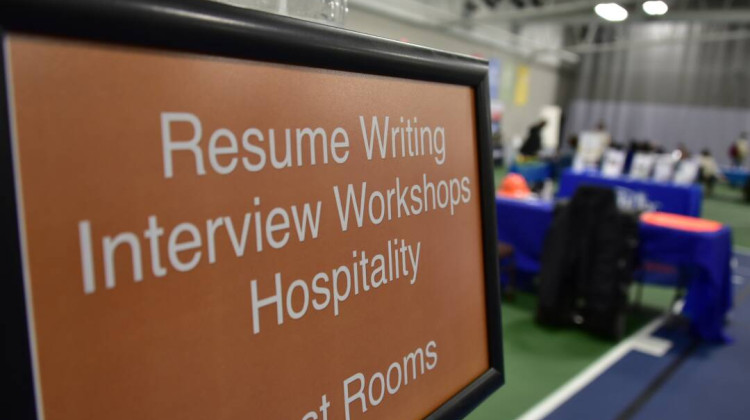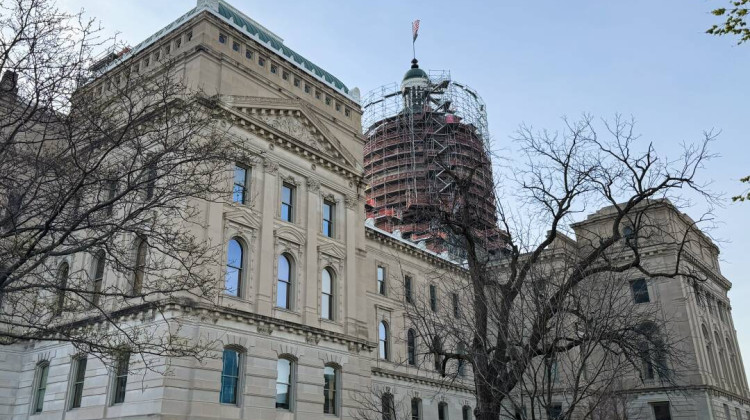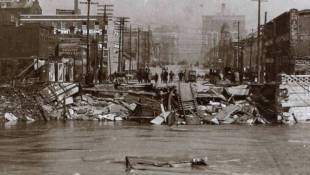
Homes near Lake Houston were almost completely under water on Wednesday. Based on the experiences of past storm victims, returning home could take years.
Win McNamee/Getty ImagesNow that the rain has stopped and floodwaters are slowly starting to recede, government officials are figuring out where tens of thousands of evacuees in Texas and Louisiana can stay.
The White House estimates about 100,000 houses were affected by the storm. Many were destroyed or are too damaged to live in. More than 30,000 people are staying in emergency shelters and will soon be in need of permanent accommodations.
Based on the experience of people whose homes were damaged after Hurricane Katrina and Superstorm Sandy, it could be months, even years, before flood victims will be able to return home.
Finding temporary housing is one of the biggest challenges in disaster recovery, says former FEMA official Brad Gair. He was thankful to see so many rescues this week but says he also had another reaction.
"Most people are looking at it and saying, 'Thank God, we've saved another family.' I look at it and say, 'Oh my God, there's another family we're going to have to figure out how to find housing for. And one more family that's starting off on a journey, or more likely an ordeal, that will go on for many years to come,' " says Gair.
"I want to be home"
Retiree Boyd Coble is one of those who wants to return home as soon as possible, but it's unclear when he can. He was staying at a temporary shelter in the Al-Salam mosque in Houston, after sheriff's deputies insisted he leave his house earlier this week.
"I didn't want to leave my home behind. I've lived there for 30 years. Never had water in the house. I want to be home," Coble says. But when he left, the floodwaters were rising and his floors had already buckled.
Gair, who oversaw recovery efforts after Katrina and Sandy, thinks thousands of people like Coble will need temporary homes. But he says the options are limited.
"Nobody has the capacity to just all of a sudden build back tens of thousands of homes overnight," he says.
Gair says in addition to the 30,000 people in emergency shelters, many more are probably staying with family and friends and will likely need somewhere else to go in the coming weeks.
FEMA officials say about 8,000 families have been moved into hotel rooms and they hope to get more people relocated there soon. They're also looking at apartments and other rental options, although it's unclear how many units are available.
"The state of Texas is about to undergo one of the largest housing recovery missions the nation has ever seen," FEMA Administrator Brock Long said earlier this week.
Long said the goal is to get people out of emergency shelter as soon as possible. He noted that financial assistance is available from HUD and other government agencies for those seeking temporary housing.
He said they're trying to save flooded homes as quickly as possible, which means sending in teams to clean out the muck and debris and to make basic repairs, so residents can move back in.
Trailers and manufactured housing a "last resort"
Long said that manufactured housing and travel trailers, such as those used to house people after Hurricane Katrina, are "a last resort." Some Katrina victims ended up living in those trailers for years and blamed them for causing severe breathing and other medical problems. He said that FEMA has a limited number of manufactured housing units in stock and that it will take time to purchase and produce more.
"We don't just start dragging in manufactured homes and travel trailers right off the bat. They're not going to be on your property tomorrow by any means," he said.
Still, the Texas Manufactured Housing Association is gearing up to help. Executive Director D.J. Pendleton says the group has been in contact with state and FEMA officials. And members of his group, including retailers and manufacturers, are taking inventory right now to see how many units are available and how quickly factories can ramp up production, if needed.
"Our goal is to just be here to be a resource," says Pendleton. "And try to help people recover as fast as possible."
Gair says such housing might very well be needed, although it can be costly — as much as $250,000 to purchase, set up and maintain a unit. He prefers what was done after Sandy, which was to make fast, minimal repairs, so people can get back into their homes as they wait for more permanent repairs to be completed.
So far no one has mentioned pursuing another housing option used widely after Katrina, which was to send tens of thousands of New Orleans flood victims to stay in other cities. Many decided to relocate permanently, and as it turned out, a major destination was Houston.
NPR's Rebecca Davis contributed to this story.
9(MDEwMDc1MzM3MDEzNDczOTA0MDc1MzViMQ001))
 DONATE
DONATE






 View More Programs
View More Programs


 Support WFYI. We can't do it without you.
Support WFYI. We can't do it without you.